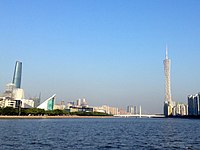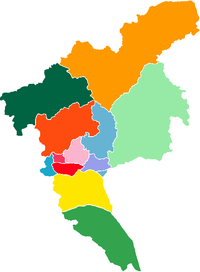Guangzhou
Guangzhou
广州 Gwong Zau · Canton | |
|---|---|
| 广州市 | |
| From top: Tianhe CBD, Statue of Five Goats, Guangzhou Baiyun International Airport ,Sun Yat-Sen Memorial Hall, Canton Fair Pazhou Expo Complex , and Pearl River Bridge. From top: Tianhe CBD, Statue of Five Goats, Guangzhou Baiyun International Airport ,Sun Yat-Sen Memorial Hall, Canton Fair Pazhou Expo Complex , and Pearl River Bridge. | |
| Nickname(s): The Flower City, Five Goats City, Goat City, Wheats City, Ceiba City, Immortals City | |
 Location of Guangzhou within Guangdong in China | |
| Country | China |
| Province | Guangdong |
| Officiated | 1918 |
| Government | |
| • Mayor | Zhang Guangning |
| Area | |
| 7,434.4 km2 (2,870.4 sq mi) | |
| • Urban | 3,843.4 km2 (6,000 sq mi) |
| Elevation | 11 m (37 ft) |
| Population (2007)[1] | |
| 10,045,800 | |
| • Density | 1,351/km2 (3,500/sq mi) |
| • Urban | 8,747,300‡ |
| • Metro | 9,754,600[citation needed] |
| Time zone | UTC+8 (UTC) |
| Postal code | 510000 |
| Website | http://www.gz.gov.cn |
| Footnote: ‡ Refers to shìxiáqū | |
Template:Fixbunching Guangzhou[2] (simplified Chinese: 广州; traditional Chinese: 廣州; pinyin: Guǎngzhōu; jyutping : Gwong²zau¹; Yale: Gwóngjàu), in English and other European languages also known as Canton[3] (which was first romanized from the Cantonese pronunciation of Guangdong by the Portuguese) and also known as Kwangchow, is a sub-provincial city and the capital of Guangdong Province in the southern part of the People's Republic of China.
It is a port on the Pearl River, navigable to the South China Sea, and is located about 120 km (75 miles) northwest of Hong Kong. As of the 2000 census, the city has a population of 6 million,[citation needed] and an urban area population of roughly 11.85 million,[4] making it the most populous city in the province and the third most populous metropolitan area in China. The provincial government's official estimate of the metropolitan area's population at the end of 2006 was 9,754,600.[citation needed] Guangzhou's urban land area is the third largest in China, behind only Beijing and Shanghai.
History
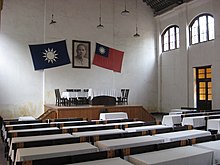
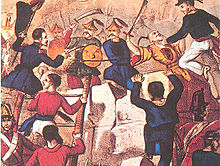
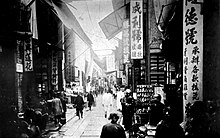
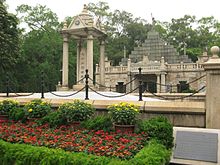
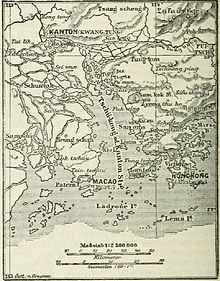
The first known city built at the site of Guangzhou was Panyu (Fan-Yü) ( 蕃禺, later simplified to 番禺; Poon Yu in Cantonese) founded in 214 BC.[citation needed] The city has been continuously occupied since that time. Panyu was expanded when it became the capital of the Nanyue Kingdom (南越) in 206 BC.
The Han Dynasty annexed Nanyue in 111 BC, and Panyu became a provincial capital and remains so today. In 226 AD, the city however became the seat of the Guang Prefecture (廣州; Guangzhou). Therefore, "Guangzhou" was the name of the prefecture, not of the city. However, people grew accustomed to calling the city Guangzhou, instead of Panyu.[citation needed]
Although the Chinese name Guangzhou replaced Panyu as the name of the walled city, Panyu was still the name of the area surrounding the walled city until the end of Qing era.[citation needed]. Today, Panyu generally refers to the region to the south of Haizhu District, which is separated by the Pearl River.
Arab and Persian pirates sacked Guangzhou (known to them as Sin-Kalan) in AD 758, ² according to a local Guangzhou government report on October 30 758, which corresponded to the day of Guisi (癸巳) of the ninth lunar month in the first year of the Qianyuan era of Emperor Suzong of the Tang Dynasty.[5][6][7] The Arab historian Abu Zayd Hasan of Siraf reports that in 878 followers of the Chinese rebel leader Huang Chao besieged the city and killed a large number of foreign merchants resident there.[8][9]
During the Northern Song Dynasty, the celebrated poet Su Shi (Shisu) visited Guangzhou's Baozhuangyan Temple and wrote the inscription "Liu Rong" (Six Banyan Trees) because of the six banyan trees he saw there. It has since been called the Temple of the 6 Banyan Trees.
The Portuguese were the first Europeans to arrive in Guangzhou by sea, establishing a monopoly on the external trade out of its harbor by 1511.[citation needed] They were later expelled from their settlements in Guangzhou (Cantão in Portuguese), but instead granted use of Macau as a trade base with the city in 1557. They would keep a near monopoly on foreign trade in the region until the arrival of the Dutch in the early seventeenth century.
It is believed that the romanization "Canton" originated from Portuguese Cantão, which was transcribed from Guangdong. Nevertheless, because at the time of the Portuguese arrival the capital city had no specific appellation other than Shang Sheng(省城, lit. the provincial capital) by its people, the province name was adopted for the walled city by the Europeans. The etymology of Canton, as well as the similar pronunciation with the province name Guangdong might have partly contributed to the recent confusion of Canton and Guangdong by certain English speakers. However, definitive English lexica, such as Merriam–Webster's Dictionary, American Heritage Dictionary and Longman Dictionary of Contemporary English don't list Guangdong as a synonym (or variant) under Canton.
After China gained control of Taiwan in 1683, the Qing government became more open to foreign trade. Guangzhou quickly emerged as one of the most suitable ports for international trade and before long ships arrived from all over the world.
The Portuguese in Macau, the Spanish in Manila, Armenians, and Muslims from India were already actively trading in the port by the 1690s, when the French and English began frequenting the port through the Canton System.
Other companies were soon to follow: the Ostend General India company in 1717; Dutch East India Company in 1729; the first Danish ship in 1731, which was followed by a Danish Asiatic Company ship in 1734; the Swedish East India Company in 1732; followed by an occasional Prussian and Trieste Company ship; the Americans in 1784; and the first ships from Australia in 1788.
By the middle of the 18th century, Guangzhou had emerged as one of the world's great trading ports under the Thirteen Factories, which was a distinction it maintained until the outbreak of the Opium Wars in 1839 and the opening of other ports in China in 1842. The privilege during this period made Guangzhou one of the top 3 cities in the world.[10]
In 1918, the city's urban council was established and "Guangzhou" became the official name of the city.[citation needed] Panyu became a county's name to the southern side of Guangzhou.
In both 1930 and 1953, Guangzhou was promoted to the status of a Municipality, but each time promotion was rescinded within a year[citation needed].
Japanese troops occupied Guangzhou from October 12, 1938 to September 16, 1945, after violent bombings. In the city, the Imperial Japanese Army conducted bacteriological research unit 8604, a section of unit 731, where Japanese doctors experimented on human prisoners.
After the fall of the capital Nanjing in April 1949, the Nationalist government under the acting president Li Zongren relocated to Guangzhou.
Communist forces entered the city on October 14, 1949. This led the nationalists to blow up the Haizhu bridge as the major link across the Pearl River and to the acting president's leaving for New York, whereas Chiang Kai-shek set up a the capital for the Nationalist government in Chongqing again. Their urban renewal projects of the new communist government improved the lives of some residents. New housing on the shores of the Pearl River provided homes for the poor boat people. Reforms by Deng Xiaoping, who came to power in the late 1970s, led to rapid economic growth due to the city's close proximity to Hong Kong and access to the Pearl River.
As labor costs increased in Hong Kong, manufacturers opened new plants in the cities of Guangdong including Guangzhou. As the largest city in one of China's wealthiest provinces, Guangzhou attracts farmers from the countryside looking for factory work. Cantonese links to overseas Chinese and beneficial tax reforms of the 1990s have aided the city's rapid growth.
In 2000, Huadu and Panyu were merged into Guangzhou as districts, and Conghua and Zengcheng became county-level cities of Guangzhou.
Based on a report in the Guangzhou Daily, there might be as many as 100,000 Africans in Guangzhou, a number that the newspaper reports has been increasing at an annual rate of 30 to 40% since 2003.[11][12][unreliable source?]
Administrative divisions
Guangzhou is a sub-provincial city. It has direct jurisdiction over ten districts (区 qu) and two county-level cities (市 shi) :
| Map | Subdivision | Hanzi | Population as of 2006 | Land area km² |
|---|---|---|---|---|

| ||||
| Guangzhou City Proper | ||||
| ■ Yuexiu-qu | 越秀区 | 1,151,481 | 32.82 | |
| ■ Liwan-qu | 荔湾区 | 705,262 | 62.40 | |
| ■ Haizhu-qu | 海珠区 | 890,512 | 90.4 | |
| ■ Tianhe-qu | 天河区 | 645,453 | 141 | |
| Guangzhou Suburban and Rural | ||||
| ■ Baiyun-qu | 白云区 | 767,688 | 825 | |
| ■ Huangpu-qu | 黄埔区 | 193,641 | 122 | |
| ■ Huadu-qu | 花都区 | 636,706 | 961 | |
| ■ Panyu-qu | 番禺区 | 947,607 | 661.88 | |
| ■ Nansha-qu | 南沙区 | 147,579 | 544.12 | |
| ■ Luogang-qu | 萝岗区 | 167,360 | 389.06 | |
| ■ Zengcheng-shi | 增城市 | 810,554 | 1,741.4 | |
| ■ Conghua-shi | 从化市 | 543,377 | 1,974.5 | |
As of April 28, 2005, the districts of Dongshan and Fangcun have been abolished and merged into Yuexiu and Liwan respectively; at the same time the district of Nansha was established out of parts of Panyu, and the district of Luogang was established out of parts of Baiyun, Tianhe, and Zengcheng, plus a part of Huangpu, making an exclave next to Huangpu.
| Guangzhou | |||||||||||||||
|---|---|---|---|---|---|---|---|---|---|---|---|---|---|---|---|
| Simplified Chinese | 广州 | ||||||||||||||
| Traditional Chinese | 廣州 | ||||||||||||||
| Jyutping | Gwong² zau1 | ||||||||||||||
| Hanyu Pinyin | Guǎngzhōu | ||||||||||||||
| Postal | Canton | ||||||||||||||
| |||||||||||||||
Development plan
In January 2009 the National People's Congress approved a development plan for the Pearl River Delta Region. On March 19, 2009 the Guangzhou Municipal Government and Foshan Municipal Government both agreed to establish a framework to merge the two cities.[13]
Significant modern buildings
- Guangdong Olympic Stadium (simplified Chinese: 广东奥林匹克体育场; traditional Chinese: 廣東奧林匹克體育場; pinyin: guǎngdōngàolínpǐkètǐyùchǎng; Cantonese Jyutping=Gwong2 Dung1 Ou3 Lam4 Pat1 Haak1 Tai2 Yuk6 Ceung4)
- CITIC Plaza (simplified Chinese: 中信广场; traditional Chinese: 中信廣場; pinyin: zhōngxìnguǎngchǎng; Cantonese Jyutping=Zung1 Seon3 Gwong2 Ceung4)
- Guangzhou TV & Sightseeing Tower (simplified Chinese: 广州电视观光塔; traditional Chinese: 廣州電視觀光塔; pinyin: guǎngzhōudiànshìguānguāngtǎ; Cantonese Jyutping=Gwong2 Zau1 Din6 Si6 Gun1 Gwong1 Taap3)
- Guangzhou TV Tower (simplified Chinese: 广州电视塔; traditional Chinese: 廣州電視塔; pinyin: guǎngzhōudiànshìtǎ; Cantonese Jyutping=Gwong2 Zau1 Din6 Si6 Taap3)
- Pearl River Tower (Chinese: 珠江城; pinyin: zhūjiāngchéng; Cantonese Jyutping=Zyu1 Gong1 Sing4)
- West Tower / Guangzhou International Finance Centre (simplified Chinese: 西塔/广州国际金融中心; traditional Chinese: 西塔/廣州國際金融中心)
Economy


Guangzhou is the main manufacturing hub of the Pearl River Delta, one of mainland China's leading commercial and manufacturing regions. In 2008, the GDP reached ¥821.58 billion (US $118 billion), per capita was ¥81,233 (US $11,696)[14], ranking 6th among the other 659 Chinese cities.[citation needed]
The China Import and Export Fair, also called "Canton Fair", is held every year in April and October by Ministry of Trading. Inaugurated in the spring of 1957, the Fair is a major event for the city. From the 104th session, Liuhua Complex is not in use to hold Canton Fair. All the booths have been transferred to Pazhou Complex. From the 104th session, Canton Fair has been arranged in 3 phases instead of 2 phases.
Industrial zones
- Guangzhou Economic and Technological Development Zone
- Guangzhou Nansha Development Zone
- Shantou Free Trade Zone
Science City
Malls
Shangxiajiu One South China Mall: World's second largest mall.
Geography and climate
Guangzhou is located at 112°57'E to 114°3'E and 22°26'N to 23°56'N. The city is part of the Pearl River Delta.
Guangzhou has a humid subtropical climate influenced by the Asian monsoon. Summers are wet with high temperatures, high humidity and a high heat index. Winters are mild, dry and sunny.
Transportation
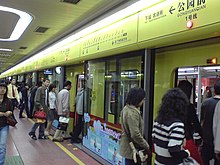
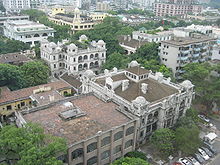

IFC/West Tower (right) and Guangzhou Opera House (front) under construction
With the first line of Guangzhou Metro opened in 1997, Guangzhou is the fourth city in Mainland China to have an underground railway system, behind Beijing, Tianjin and Shanghai. Currently the underground network is made up of four lines, covering a total length of 116 km, while another four lines are under construction and due to be completed in 2010 before the Asian Games. A long term plan is to make the city's underground system expand over 500 km by 2020 with 15 lines in operation.
The existing four lines of Guangzhou Metro network:
- Line 1 (Fangcun Line): From Guangzhou East Railway Station to Xilang Station
- Line 2 (Jiahe Line): From Sanyuanli Station to Wanshengwei Station
- Line 3 (Shiqiao Line): From Guangzhou East Railway Station and Tianhe Coach Terminal Station to Panyu Square Station
- Line 4 (Guangzhou University Town Line): From Wanshengwei Station to Jinzhou Station
- Line 5 (Huanshi Line):From Jiaokou Station to Wenchong Station
Guangzhou's main airport is the Baiyun International Airport in Huadu District opened on August 5, 2004. It replaced the old Baiyun International Airport, which was very close to the city centre and failed to meet the fast-growing air traffic demand.
Guangzhou is well connected to Hong Kong by train, coach and ferry. The Guangdong Through Train departs from the Guangzhou East railway station (simplified Chinese: 广州东站; traditional Chinese: 廣州東站; pinyin: Gǔangzhōu Dōngzhàn) and arrive at the Hung Hom KCR station in Kowloon, Hong Kong. The route is approximately 182 km in length and the ride takes less than two hours. Frequent coach services are also provided with coaches departing every day from different locations (mostly major hotels) around the city.
There are daily ferry services including an overnight ferry service, which takes eight hours, as well as high-speed catamaran service which takes three hours, to the China Ferry Terminal or Macau Ferry Pier in Hong Kong. The Nansha Pier (新南沙客運港), located in the distant Nansha District outside the city centre, is also operating six daily 75-minute catamaran services to Hong Kong.
From January 1, 2007, the municipal government has banned motorcycles in the urban areas. Motorcycles found violating the ban will be confiscated.[15] The Guangzhou traffic bureau claimed to have reported reduced traffic problems and accidents in the downtown area since the ban.[16]
According to a report on the China Daily of July 6, 2007, all buses and taxis in Guangzhou will be LPG-fueled by 2010 to promote clean energy for transportation and improve the environment.[17] At present, Guangzhou is the city that uses the most LPG-fueled vehicles in the world. As of the end of 2006, 6,500 buses and 16,000 taxis were using LPG, taking up 85% of all buses and taxis.
Local products
- Canton Province Sculpture is legendary and includes Guangzhou Ivory Carvings, Jade Sculpture, Wood Sculpture and Olive Sculpture.
- Cantonese Enamel includes Guangzhou Colorful Pottery. It has a history of over 300 years.
- Cantonese Embroidery, namely "Yue 粤 Embroidery" (meaning literally "Guangdong embroidery")is one of the Four Famous Chinese Embroideries together with Su Embroidery, Xiang Embroidery and Shu Embroidery.
- Canton Province Bacon is the general designation of cured meat in the Guangzhou and surrounding areas.
- Zhujiang Beer(Pearl River Beer)
Culture
Parks and gardens
- Baiyun Mountain (simplified Chinese: 白云山; traditional Chinese: 白雲山; pinyin: Báiyúnshān; literally "White Cloud Mountain"; Cantonese Jyutping=Bak6 Wan4 Saan1)
- Yuexiu Park (simplified Chinese: 越秀公园; traditional Chinese: 越秀公園; pinyin: yuèxiùgōngyuán; Cantonese Jyutping=Jyut6 Sau3 Gung1 Jyun2)
- Luhu Park (simplified Chinese: 麓湖公园; traditional Chinese: 麓湖公園; Cantonese Jyutping=Luk1 Wu4 Gung1 Jyun2)
- Dongshanhu Park (simplified Chinese: 东山湖公园; traditional Chinese: 東山湖公園; Cantonese Jyutping=Dung1 Saan1 Wu4 Gung1 Jyun2)
- Liuhuahu Park (simplified Chinese: 流花湖公园; traditional Chinese: 流花湖公園; Cantonese Jyutping=Lau4 Faa3 Wu4 Gung1 Jyun2)
- Liwanhu Park (simplified Chinese: 荔湾湖公园; traditional Chinese: 荔灣湖公園; Cantonese Jyutping=Lai6 Waan1 Wu4 Gung1 Jyun2)
- Yuntai Garden (simplified Chinese: 云台花园; traditional Chinese: 雲台花園; Cantonese Jyutping=Wan4 Toi4 Faa1 Jyun2)
- Martyrs' Park (simplified Chinese: 广州起义烈士陵园; traditional Chinese: 廣州起義烈士陵園; pinyin: lièshìlíngyuán; Cantonese Jyutping=Lit6 Si6 Ling4 Jyun4)
- Zhujiang Park (simplified Chinese: 珠江公园; traditional Chinese: 珠江公園; Cantonese Jyutping=Zyu1 Gong1 Gung1 Jyun2)
- South China Botanical Garden (simplified Chinese: 华南植物园; traditional Chinese: 華南植物園; Cantonese Jyutping=Waa4 Naam4 Zik6 Mat6 Jyun4)
Tourist attractions



Guangzhou has a humid, hot sub-tropical climate. Annual average temperature is 21.8 degrees. Autumn, from October to December, is very moderate, cool and windy, and is the best travel time.[18] There are many tourist attractions around the city which include:
- Chen Clan Academy/Chan Clan Ancestral Hall (simplified Chinese: 陈氏书院/陈家祠; traditional Chinese: 陳氏書院/陳家祠; pinyin: ChénShìShūYùan/ChénJiāCí; Cantonese Jyutping=Can4 Si6 Syu1 Jyun2/Can4 Gaa1 Ci4)
- Guangdong Museum of Folk Handcraft
- Shamian Island / Shameen Island (simplified Chinese: 沙面岛; traditional Chinese: 沙面島; pinyin: Shāmàndăo; Cantonese Jyutping=Saa1 Min2 Dou2; literally, "Sand Face Island")
- Guangdong Provincial Museum (simplified Chinese: 广东省博物馆; traditional Chinese: 廣東省博物館; pinyin: Guǎngdōngshěng Bówògǔan; Cantonese Jyutping=Gwong2 Dung1 Saang2 Bok3 Mat6 Gun2)
- Museum of the Tomb of the King of Southern Yue in Western Han Dynasty; Traditional Chinese=西漢南越王博物館; Cantonese Jyutping=Sai1 Hon3 Naam4 Jyut6 Wong4 Bok3 Mat6 Gun2
- Temple of the Six Banyan Trees (Chinese: 六榕寺; pinyin: liùróngsì; Cantonese Jyutping=Luk6 Jung4 Zi2)
- Sacred Heart Cathedral / Stone House; Traditional Chinese=聖心石室大教堂/石室; Cantonese Jyutping=Sek6 Sat1
- Huaisheng Mosque (simplified Chinese: 怀圣寺; traditional Chinese: 懷聖寺; pinyin: huáishèngsì; Cantonese Jyutping=Waai4 Sing3 Zi2)
- Temple of Bright Filial Piety (Chinese: 光孝寺; pinyin: GuāngXiàosì; Cantonese Jyutping=Gwong1 Haau3 Zi2)
- Chime-Long Paradise (simplified Chinese: 长隆欢乐世界; traditional Chinese: 長隆歡樂世界; pinyin: chánglónghuānlèshìjiè; Cantonese Jyutping=Ceung4 Lung4 Fun1 Lok6 Sai3 Gaai3)
- Chime-Long WaterPark (simplified Chinese: 长隆水上乐园; traditional Chinese: 長隆水上樂園; pinyin: chánglóngShǔiShànglèYúan; Cantonese Jyutping=Ceung4 Lung4 Seoi2 Seung6 Lok6 Jyun4)
- Museum of the Western Han Dynasty Mausoleum of the Nanyue King南越王墓(Chinese: 南越王墓; pinyin: nányuėwángmù; Cantonese Jyutping=Naam4 Jyut6 Wong4 Mou6)
- Guangzhou Peasant Movement Institute (simplified Chinese: 广州市农民运动讲习所; traditional Chinese: 廣州農民運動講習所; pinyin: GuǎngZhōuNóngMíngJiǎngXíSuǒ; Cantonese Jyutping=Gwong2 Zau1 Nung4 Man4 Wan6 Dung6 Gong2 Zaap6 So2)
Media
Guangzhou has two local radio stations, the provincial Radio Guangdong and the municipal Radio Guangzhou. Together they broadcast Cantonese and Mandarin programmes in more than a dozen channels. The Beijing-based China National Radio broadcasts Putonghua programmes in the city. On the other hand, radio stations from cities around Guangzhou mainly broadcast in Cantonese whose programmes can be received in different parts of the city, depending on their locations and power. Radio Guangdong produces a 15-minute weekly English programme, Guangdong Today, which is broadcast globally through the World Radio Network but not in local channels. Daily English news and several other short weekly English programmes are also produced by Radio Guangdong.
Both TVB Pearl and ATV World, two major English channels in Hong Kong, can be received through cable TV in Guangzhou. The local Guangzhou Television also has its own English channel which runs all-English programmes from evening to midnight every day.
Guangzhou has some of the best Chinese-language newspapers in Mainland China, published by three big newspaper groups in the city. The Guangzhou Daily Press Group, Nanfang Press Corporation and Yangcheng Evening News Group dominate the newspaper market of Guangdong Province or even South Mainland China. The two leading newspaper of the city are Guangzhou Daily and Southern Metropolis Daily. Guangzhou Daily, with a circulation of 1.8 million, has been China's most successful newspaper for 14 years in terms of advertising revenue. In addition to Guangzhou's Chinese-language publications, there are a few English magazines and newspapers, most notably that's PRD (formerly that's Guangzhou) which was started more than a decade ago and has since blossomed into one of China's leading expat magazines with issues in Beijing, Shanghai and formerly Suzhou.
Education
Higher education institutes

National universities
- Sun Yat-sen University (中山大学) (founded in 1924)
- South China University of Technology (华南理工大学)
- South China Normal University (华南师范大学)
- Jinan University (暨南大学) (founded in 1906)
- Guangdong University of Foreign Studies (广东外语外贸大学)
- South China Agricultural University (华南农业大学) (founded in 1909)
Public universities and colleges
- Guangdong University of Finance (广东金融学院)
- Zhongkai Agrotechnical College (仲恺农业技术学院) (founded in 1927)
- Guangzhou Medical College (广州医学院)
- Guangzhou University of Chinese Medicine (广州中医药大学)
- Guangdong Pharmaceutical University (广东药学院)
- Guangdong University of Technology (广东工业大学)
- Guangzhou University (广州大学)
- Guangdong Institute of Science and Technology (广东省科技干部学院)
- Guangdong University of Business Studies (广东商学院)
- Guangzhou Academy of Fine Arts (广州美术学院)
- Xinghai Conservatory of Music (星海音乐学院)
- Guangdong Polytechnic Normal University (广东技术师范学院)
- Guangzhou Sports University (广州体育学院)
Note: Institutes without full-time bachelor programs are not listed.
Guangzhou Higher Education Mega Centre
Guangzhou Higher Education Mega Centre also known as Guangzhou University City is a large university complex located in the southeast suburbs of Guangzhou. This huge higher education centre occupies the entire Xiaoguwei island in Panyu District, covering an area of about 18 square kilometres. It houses new campuses from ten universities, nine of which still maintain their old campuses in downtown Guangzhou. The whole Higher Education Mega Centre can eventually accommodate up to 200,000 students, 20,000 teachers and 50,000 staffs.[19]
Universities which have campuses in the Mega Centre:
- Sun Yat-sen University (中山大学)
- South China University of Technology (华南理工大学)
- South China Normal University (华南师范大学)
- Guangdong University of Technology (广东工业大学)
- Guangdong University of Foreign Studies (广东外语外贸大学)
- Guangzhou University of Chinese Medicine (广州中医药大学)
- Guangdong Pharmaceutical University (广东药学院)
- Guangzhou University (广州大学)
- Guangzhou Academy of Fine Arts (广州美术学院)
- Xinghai Conservatory of Music (星海音乐学院)
Secondary and high schools
- The Affiliated High School of South China Normal University (simplified Chinese: 华南师范大学附属中学; traditional Chinese: 華南師範大學附屬中學; pinyin: HuáNánShĩFànDàXúeFùShǔZhōngXúe; Cantonese Jyutping=Waa4 Naam4 Si1 Faan6 Daai6 Hok6 Fu6 Suk6 Zung1 Hok6)
- Guangzhou Zhi Xin Middle School (simplified Chinese: 广州市执信中学; traditional Chinese: 廣州市執信中學; pinyin: GuăngZhōuZhíXìnZhōngXúe; Cantonese Jyutping=Gwong2 Zau1 Si5 Zap1 Seon3 Zung1 Hok6)
- Guangdong Experimental High School (simplified Chinese: 广东实验中学; traditional Chinese: 廣東實驗中學; pinyin: GuăngDōngShíYànZhōngXúe; Cantonese Jyutping=Gwong2 Dung1 Sat6 Yim6 Zung1 Hok6)
- Guangdong Guangya Middle School (simplified Chinese: 广东广雅中学; traditional Chinese: 廣東廣雅中學; pinyin: GuăngDōngGuăngYàZhōngXúe; Cantonese Jyutping=Gwong2 Dung1 Gwong2 Ngaa5 Zung1 Hok6)
- Guangzhou Tieyi Middle School (simplified Chinese: 广州市铁一中学; traditional Chinese: 廣州市鐵一中學; pinyin: GuăngZhōuShìTiěYīZhōngXúe; Cantonese Jyutping=Gwong2 Zau1 Si5 Tit3 Jat1 Zung1 Hok6)
- Guangzhou No.2 High School (simplified Chinese: 广州市第二中学; traditional Chinese: 廣州市第二中學; pinyin: GuăngZhōuDìErZhōngXúe; Cantonese Jyutping=Gwong2 Zau1 Si5 Daai6 Yi6 Zung1 Hok6)
- Guangzhou No.6 High School (simplified Chinese: 广州市第六中学; traditional Chinese: 廣州市第六中學; pinyin: GuăngZhōuDìLìuZhōngXúe; Cantonese Jyutping=Gwong2 Zau1 Si5 Daai6 Luk6 Zung1 Hok6)
- Guangzhou No.7 High School (simplified Chinese: 广州市第七中学; traditional Chinese: 廣州市第七中學; pinyin: GuăngZhōuDìQiZhōngXúe; Cantonese Jyutping=Gwong2 Zau1 Si5 Daai6 Cat1 Zung1 Hok6)
- Guangzhou No.8 High School (simplified Chinese: 广州市第八中学(培英中学); traditional Chinese: 廣州市第八中學; pinyin: GuăngZhōuDìBaZhōngXúe; Cantonese Jyutping=Gwong2 Zau1 Si5 Daai6 Baat3 Zung1 Hok6)
- Guangzhou No.4 High School (Simplified Chinese:广州市第四中学 Traditional Chinese:廣州市第四中學
- Guangzhou No.47 High School (simplified Chinese: 广州市第四十七中学; traditional Chinese: 廣州市第四十七中學; pinyin: GuăngZhōuDìSìShíQiZhōngXúe;)
International schools
- American International School of Guangzhou
- The British School of Guangzhou
- Guangzhou Japanese School
- Utahloy International School of Guangzhou
- Clifford International School
- Guangzhou Nanhu International School
- International French School of Canton
Sports
Current professional sports clubs (football and basketball) based in Guangzhou include:
International relations

Twin towns — Sister cities
Guangzhou is twinned with the following cities:
| Country | City | County/District/Region/State | Date |
|---|---|---|---|
| Fukuoka | Fukuoka | 1979 | |
| Los Angeles | California | December 6, 1981 | |
| Manila | Metro Manila | November 1982 | |
| Vancouver | British Columbia | March 1985[20] | |
| Bari | Bari | 1986 | |
| Sydney | New South Wales | May 1986 | |
| Viña Del Mar | Valparaíso | November 1986 | |
| Frankfurt am Main | Hessen | April 11, 1988 | |
| Lyon | Rhône | November 1988 | |
| Auckland | Auckland | February 1989 | |
| Gwangju | Gwangju | October 1996 | |
| Oita | Ōita | 1997 | |
| Linköping | Östergötland | November 1997 | |
| Durban | KwaZulu-Natal | July 2000 | |
| Bristol | England | May 2001[21] | |
| Yekaterinburg | Sverdlovsk | July 10, 2002 | |
| Arequipa | Arequipa | October 27, 2004 | |
| Birmingham | England | December 2006 | |
| Dubai | Dubai | 2005 | |
| Surabaya | East Java | December 2005 | |
| Recife | Pernambuco | 2007 | |
| Kota Kinabalu | Sabah | May 2009 | |
| Dhaka | Dhaka |
See also
References
- ^ a b "Area and Population of Guangzhou. 2007 estimate". The People`s Government of Guangzhou Municipality. Retrieved 2009-09-03.
- ^ MapMachine
- ^ A concise history of Hong Kong By John Mark Carroll
- ^ Demographia World Urban Areas population projections
- ^ Welsh, Frank (1974). Maya Rao (ed.). A Borrowed Place: The History of Hong Kong. p. 13. ISBN 1-56836-134-3.
- ^ Needham, Joseph (1954). Science & Civilisation in China. Cambridge University Press. pp. 1, 179.
{{cite book}}: Check|first=value (help) - ^ Sima Guang. Zizhi Tongjian (Comprehensive Mirror to Aid in Government).
- ^ Gabriel Ferrand, ed. (1922). Voyage du marchand arabe Sulaymân en Inde et en Chine, rédigé en 851, suivi de remarques par Abû Zayd Hasan (vers 916). p. 76.
- ^ Kaifung Jews. Division of Religion and Philosophy. University of Cumbria.
- ^ "Top 10 Cities of the Year 1800". About.com. Retrieved 2008-08-28.
{{cite web}}: Italic or bold markup not allowed in:|publisher=(help) - ^ China and Africa: Stronger Economic Ties Mean More Migration. By Malia Politzer. Migration Information Source. August 2008
- ^ Out of Africa and into China, immigrants struggle. Yahoo News. August 22, 2009.
- ^ Guangzhou and Foshan signed "City Merge Cooperation Framework"
- ^ "Guangzhou's GDP Per Capita Exceeds 10,000 USD, Double of Province's Average". Life of Guangzhou. 2009-01-27. Retrieved 2009-08-17.
{{cite news}}: Italic or bold markup not allowed in:|publisher=(help) - ^ "Guangzhou Bans Motorcycles". Life of Guangzhou. 2007-01-03. Retrieved 2008-08-28.
{{cite news}}: Italic or bold markup not allowed in:|publisher=(help) - ^ "Traffic Jam Improve after Motorcycle Ban". Life of Guangzhou. 2007-01-19. Retrieved 2008-08-28.
{{cite news}}: Italic or bold markup not allowed in:|publisher=(help) - ^ "Date set for LPG-fueled buses, taxis". China Daily. 2007-07-06. Retrieved 2008-08-28.
{{cite news}}: Italic or bold markup not allowed in:|publisher=(help) - ^ "Travel China Guide: Fascinating Guangzhou". Blogspot. 2008-08-12. Retrieved 2008-08-21.
{{cite web}}: Italic or bold markup not allowed in:|publisher=(help) - ^ "Mega Campus goes Wireless" (PDF). Intel Corporation. Archived from the original (PDF) on 2008-02-27. Retrieved 2008-08-28.
{{cite web}}: Italic or bold markup not allowed in:|publisher=(help) - ^ "Vancouver Twinning Relationships" (PDF). City of Vancouver. Retrieved 2009-07-18.
- ^ "Bristol City - Town twinning". © 2009 Bristol City Council. Retrieved 2009-07-17.
{{cite web}}: External link in|publisher=
Further reading
- Johnson, Graham E. (1999). Historical Dictionary of Guangzhou (Canton) and Guangdong. Lanham, MD: The Scarecrow Press. ISBN 978-0810835160.
{{cite book}}: Cite has empty unknown parameter:|coauthors=(help) - Lee, Edward Bing-Shuey (1936). Modern Canton. Shanghai: The Mercury Press.
{{cite book}}: Cite has empty unknown parameter:|coauthors=(help) - Ng, Yong Sang (1936). Canton, City of the Rams: A General Description and a Brief Historical Survey. Canton: M.S. Cheung. ASIN B0008D1HHO.
{{cite book}}: Cite has empty unknown parameter:|coauthors=(help) - Shaw, Samuel (1847). The journals of Major Samuel Shaw : the first American consul at Canton : with a life of the author. Boston: Wm. Crosby and H.P. Nichols. Retrieved 2008-04-05.
{{cite book}}: Unknown parameter|coauthors=ignored (|author=suggested) (help) - Vogel, Ezra F. (1969). Canton Under Communism: Programs and Politics in a Provincial Capital, 1949–1968. Cambridge, MA: Harvard University Press. ISBN 978-0674094758.
{{cite book}}: Check|first=value (help); Cite has empty unknown parameter:|coauthors=(help)
External links
- Guangzhou International - Official website of government of Guangzhou municipality
- Guangzhou, China Network
- Guangzhou Municipal Bureau of Tourism
- Template:Wikitravel


